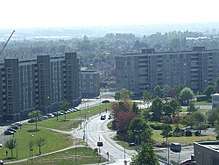Ballymun Flats
The Ballymun Flats refers to a number of flats—including the Ballymun tower blocks, seven landmark residential towers built in the 1960s—in Ballymun, Dublin. In total there were 36 blocks of Ballymun flats (7 fifteen-storey, 19 eight-storey and 10 four-storey blocks). While nothing unusual by global standards, and small compared to Eastern European or Swedish norms, they were experimental for Ireland.

They were all demolished in the early 21st century; from October 2013 all three remaining blocks were empty, and last one was demolished in September 2015.[1]
The 15-storey blocks actually had 17 storeys including the entrance floor and the plant room on the roof.
The Plunkett tower, one of the original named after the signatories of the Proclamation, was a 42-metre, 8,500-tonne building. It housed 90 families in 30 three, two and one-bed units.
There were also four-storey and eight-storey blocks.
History
The Ballymun Flats were built in the 1960s to accommodate the rising population, particularly to accommodate former residents of inner-city areas which were being cleared in the process of 1960s 'urban slum clearances'. Whilst suffering from a lack of sufficient public amenities, several schools served the area (Holy Spirit N.S. and Ballymun Comprehensive), as well as an Eastern Health Board medical centre and a purpose built shopping centre. The area suffered from many social problems such as drugs and rampant crime. The causes of these social problems, and the subsequent discrimination faced by many people with Ballymun addresses when seeking employment outside the suburb, have been disputed, but Ballymun generally paralleled the experience of many working-class people in the 1960 and 1970s when placed in high-rise locations.
Despite the negative perceptions of many non-residents of Ballymun, many of the residents insist that there is a strong sense of pride and community in the area.[2] Lynn Connolly, whose 2006 memoir The Mun: Growing Up in Ballymun detailed her raising there in the 1970s and 1980s, readily acknowledged the problems there and wanted to get out at the time.[3] But she later came to realise that there had been much that was good at the towers – in terms of a collective wit among residents and a helping sense of community – which had been ignored by the media.[3][4]
The Ballymun Flats were the first place in Ireland to receive cable television. RTE Relays Ltd, a subsidiary of the national broadcaster RTE installed cable television into the flats in 1963, giving each flat the ability to watch the main UK television channels BBC One, BBC Two, ITV (from 1982 Channel 4) as well as RTE Television via cable.[5][6]
Four-storey flats
The four-storey flats consisted of Sandyhill Avenue, Sillogue Avenue and Shangan Avenue, the height of all three were not always as visible as the higher storey flats. They were the earliest complexes to be demolished. The former flats of Sillogue Avenue are now just land whilst the former flats of Shangan Avenue have been replaced by new complexes. A new area called Marewood, consisting of houses and apartments, is now situated where the Sandyhill Avenue flats once stood.
Eight-storey flats
The eight-storey flats consisted of Balbutcher Lane (which only consisted of two blocks), Shangan Road (three blocks), Coultry Road (four blocks), Balcurris Road and Sillogue Road (five blocks each).

The flats had two different designs, the more common being with the lift on the opposite side of the stairwell, Balbutcher and Shangan were the only ones to contain just this design. Balcurris contained one of the alternative blocks, Sillogue (pictured) had two of the alternative blocks and three of the other blocks, three of the four Coultry blocks were made contained the lift on the side of the stairwell. Balcurris was the only row of flats to have its blocks separated by a road, the latter three blocks faced a different direction to the first two blocks and were the most visible from Dublin Airport.
Balbutcher Lane was upgraded in the 1990s where only residents were allowed to enter and had to buzz their way in, visitors needed permission from residents in order to enter. Windows were placed on the balconies and post would be delivered similar to how an apartment block would receive their mail. Railings were also placed around the flats and a playground was built at the back of the complex.
Sections of Coultry and Balcurris were demolished first, with the latter becoming the first complex to be completely demolished by 2009, it was originally noted that the Ballymun Shopping Centre and Metro North would be situated on the old Balcurris site, although these plans failed to materialize. Many of the complexes were demolished by 2012, after the removal of the Sillogue flats. Balbutcher Lane were the last eight-storey flats to go in 2015.
Fifteen-story flats
The Ballymun tower blocks were seven landmark residential towers built in the 1960s in Ballymun, Dublin, Republic of Ireland. The seven towers were named after the seven leaders of the 1916 rising; Patrick Pearse, Thomas MacDonagh, Sean MacDermott, Eamonn Ceannt, Thomas Clarke, James Connolly and Joseph Plunkett.
In 2004 demolition of the first tower began. The Patrick Pearse tower was demolished slowly by mechanical means, whilst MacDermott and MacDonagh Towers were demolished by controlled implosion. Ceannt, Plunkett, Clarke and Connolly towers were demolished by mechanical means.
The red aircraft warning lights on these structures were not connected to any form of back-up power for many years, leaving the towers completely dark in a power outage.
Construction/Demolition
- Patrick Pearse tower (1966–2004) was the first of the Ballymun towers to go up in 1966. Pearse Tower was halfway through construction when the construction of MacDonagh Tower started. Pearse Tower was the first tower to be demolished in 2004.
- Thomas MacDonagh tower (1966–2005) was the second tower to go up in 1966 and in 2005 was demolished by controlled implosion.
- Eamonn Ceannt tower (1966–2005) was the third tower built in 1966; in 2005 it was demolished.
- James Connolly tower (1966–2007) was the fourth tower built in 1966. In 2007 it was demolished.
- Sean MacDermott tower (1966–2005) was the fifth tower to be built, in 1966. In 2005 it was demolished by controlled implosion and went down in less than 8 seconds.
- Thomas Clarke tower (1966–2008) was the 6th tower built in 1966. Before it was demolished in 2008, the top floor was turned into a short-stay hotel.
- Joseph Plunkett tower (1967–2015) was the last built in 1967. The tower's demolition began on 22 September 2015.
Gallery
- Plunkett tower
- Connolly tower.
- Ceannt tower.
- Clarke Tower
- MacDermott Tower
- Thomas MacDonagh Tower
- Pearse Tower was the first to be demolished.
- MacDonagh Tower being demolished by controlled implosion in 2005.
- MacDermott Tower being demolished by controlled implosion in 2005.
- Ceannt Tower being demolished by mechanical means in 2005.
 Clarke tower being demolished By mechanical means in 2008.
Clarke tower being demolished By mechanical means in 2008.- Connolly tower being demolished by mechanical means in 2007.
In popular culture
- The line "I see seven towers, but I only see one way out" from U2's 1987 song "Running to Stand Still" (on The Joshua Tree album) refers to these towers.[7] The link between the towers and the song was pervasive enough to be mentioned in some tourist books about Dublin.[8]
- Ballymun flats feature in M. J. Hyland's Booker-shortlisted novel Carry Me Down (2006), symbolising John's family's descent into poverty.
- The Ballymun Trilogy is a series of three plays about the process of change in Ballymun, written by Dermot Bolger and staged by the Axis Art Centre located close to the original site of McDonagh Tower. They are From These Green Heights, The Townlands of Brazil, and The Consequences of Lightning.
- Lynn Connolly followed up her memoir with a 2012 mystery set in the Ballymun flats entitled Elizabeth III'.
- On an episode of the podcast Song Exploder, U2's Bono detailed the track "Cedarwood Road" focuses on the violence that youth faced in the Ballymun Flats community during the '70s.
- Ballymun also appears in the popular Irish film The Committments[9] where some of its residents become members of the titular band. This film was voted the best Irish film of the decade, favoured mostly for its wry humour. Some if the quips in the film directly reference[10] this part of North Dublin.
References
- PM, Cormac Murphy-10 September 2013 03:30. "Ballymun's last tower blocks to be demolished". Herald.ie. Retrieved 19 July 2019.
- "Ballymun – A History" (PDF). Retrieved 19 July 2019.
- Connolly, Lynn (2006). The Mun: Growing Up in Ballymun (paperback). Dublin: Gill & Macmillan. p. 2. ISBN 0-7171-4042-3. Chapter 1 available online Archived 21 February 2012 at the Wayback Machine.
- "The Mun: Growing Up in Ballymun by Lynn Connolly". Read Ireland Book Reviews (358). 2006. Archived from the original on 18 December 2012.
- "History of Irish Cable". Boards.ie. Retrieved 19 July 2019.
- "History of Multichannel TV in Ireland". myhome.iolfree.ie. Retrieved 19 July 2019.
- The Dubliner, "A Social History of U2 1976–2005" Archived 27 September 2007 at the Wayback Machine, 1991 entry. Retrieved 14 December 2006.
- Davenport, Fionn (2008). Dublin: City Guide (7th ed.). London: Lonely Planet. pp. 52–53. ISBN 1-74104-710-2.
- "The Commitments". Retrieved 19 July 2019 – via www.imdb.com.
- "Quotes from "The Commitments"". Retrieved 19 July 2019 – via www.imdb.com.
External links
![]()